How Content is Transforming Search Engine Optimization Strategies

SEO is changing. The old ways are dead.
Used to be all you had to do was link from anywhere you wanted hundreds or thousands of times to your website to rank. Then Google got smarter.
Then the best way to rank was adding a keyword of your choice a thousand times on one of your web pages (often with white text on a white background) and that would get you ranked. Then Google got smarter.
If you do either of these now, or similar black hat tactics, you’re on a one-way flight to getting blacklisted (AKA completely removed from the search engines).
More recently, the best way to rank was to create a list of keywords you’d want to rank for, build pages, blog a few hundred words about it and get some links off of the website to support it.
While you won’t get blacklisted for this, it’s your grandfather’s way of doing SEO.
The search engine optimization strategies of 2019, 2020 and the immediate future has one focus: content.
This post will do a deep dive into how content is changing the way your website can compete online. Of course content isn’t the only thing you need to rank in Google so let’s look at the basics before we do a deep dive shall we?
The Main Components Every SEO Strategy Needs
SEO can be conveniently broken down into three components:
- Technical SEO (there’s also on-page optimization but I’m going to rope that in to content)
- User-Experience
- Content Management (Click here to skip to the content section. That’s why you’re here, right?)
Technical SEO
One of the main reasons you might hire a search engine optimization company is to set your site up for success.
That starts with technical SEO.
To the layman, technical SEO’s purpose is to organize your site in a way that follows Google’s guidelines. By doing so, your website is speaking to the search engine algorithms the exact way they want to be spoken to from a structural standpoint.
Each of the below items could have their own blog post but every website should be able to check off these boxes:
- The website is secure with https://
- The page titles are of the appropriate length and descriptive (60-70 characters generally)
- The meta descriptions explain in more detail what’s on the page and are the appropriate length (100-120 characters generally)
- There is an XML sitemap
- There is a robots.txt file present
- All appropriate pages can be indexed
- The site is mobile friendly
- The site loads quickly
- The site has Google Analytics so the site owner can monitor visitor data
How easy it is to accomplish all this depends on your website CMS (content management system) and your hosting provider.
Generally the best platform to see the highest rankings in Google is Wordpress. Wordpress is set up to cross off the above technical SEO bullet points with relative ease.
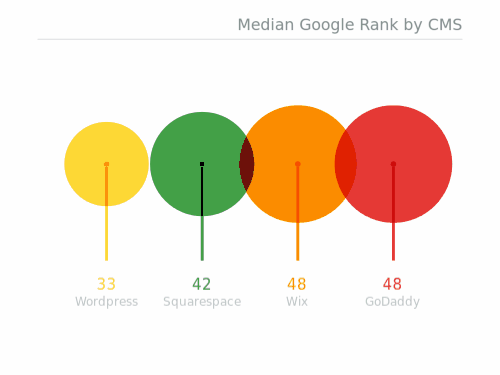
Wordpress isn’t necessarily in a class of its own or the only CMS you can use, though. A lot of other great platforms include:
- HubSpot (more on this in the content section)
- Magento or Shopify (for e-commerce websites)
- Squarespace and Wix (probably the easiest to build for non-web designers)
- And many more
For the sake of this blog, we’re going to explain why we’re biased towards HubSpot when it comes to truly having a heavily focused content management strategy for SEO.
User-Experience
Picture yourself at a Subway restaurant. You’ve been there before, you know what you like. You walk up to the counter, everything is familiar. The bread comes first, then the choice of meat and cheese, “What veggies would you like sir?”, and top it off with whatever sauce you like.
Familiar. Quick. Effortless.
This is how a website should feel.
User-experience is playing a more vital role in ranking well online and of course, converting your website traffic into leads and sales, than ever before.
Websites that make information hard to find, don’t explain plainly what products or services are on offer and are difficult to navigate through are killers to your company’s potential growth.
Your website’s #1 job is to turn one-way communication into two-way communication. If it’s hard to understand and use, loads too slowly or doesn’t fit well on all screens, your website is failing, plain and simple.
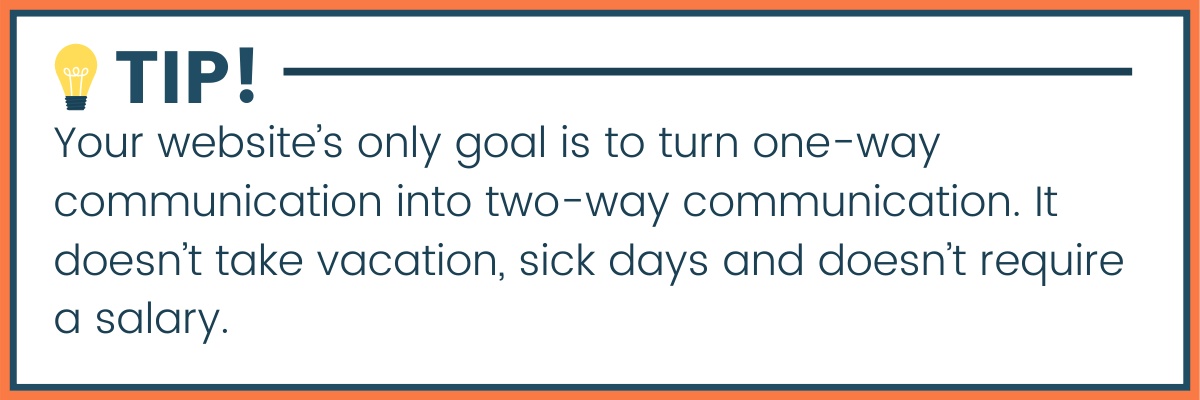
If you’re saying to yourself, “I want our website to be our #1 employee” then here are a few things you need to make sure it includes:
- It loads quickly. Did you know that for every second your website takes to load you lose 10% of people? Can you afford to have a site that takes more than a couple seconds to show up?
- It fits on all screens. Also known as responsive. It should look good on a desktop, an iPhone, a tablet and every dimension in between. If it doesn’t, you’ve lost your credibility. Who would do business with a company who isn’t even concerned with their own image?
- The menu navigation is easy to use. It should be easy to read and move through. If you have drop-down menus, make sure they don’t dominate the page. If you have a lot of categories on your site, either simplify your menu or make sure they can all be plainly seen when navigating.
- They should always see a way to contact you. Having your phone number at the top, having a “Quote Request” button in a different color or having the menu follow the mouse as you scroll. One or all of these will increase your website’s ability to convert traffic to leads.
These are the absolute minimums to help your website convert or at least be effortless to use.
Where you truly turn site visitors into leads though is through a well-thought-out SEO strategy focused on content management.
Content Management for SEO
You’re here! Welcome.
While I said earlier that choosing keywords and writing content on your website with good linking strategies is dead. That’s not entirely true. The reality is, it’s dying off but not dead and buried.
What SEOs are seeing is a much larger emphasis on content creation and how it conforms to the intent of people searching in Google.
In short, you still need quality linking, technical SEO and a good user-experience to be truly successful online but none of that will do you any good without the proper content strategy in place.
At Agency Jet, we use HubSpot because they are truly the pioneers and masters of shaping the future for content online. They’ve been doing it for years but in this day and age their strategies are more important to getting your website ranked than ever. This post by Drew Fortin does a fantastic job explaining it. We’re going to pull some of Drew’s (and HubSpot’s) ideas and add in a few of own.
It’s All About The Content
So why the great shift? If all you had to do was copy and paste keywords on a page 15 years ago, why can’t you do it now?
The reality is we’ve traveled further in the digital world in the last 10 years than we have in the previous 100.
Google is constantly trying to serve up the best results based on the intent of your search. This means, websites need to account for that intent. You can’t just describe your products and services any more, you need to relate how they are important to the end user. Your website can’t just be a billboard with facts, it needs to connect to the person browsing it.
Having content that is engaging, informative and useful to your website visitors will be the absolute key in turning those visitors into followers, those followers into leads, and those leads into sales.
Search engine optimization strategies are changing to fit this style of consumer and to serve the customer and beat out your competition, you’ll need to get on board.
Here’s how you do it.
Establish Your Core Offerings and Make Them Keywords
This is why keyword strategies aren’t dead. Traditional keyword research might be but utilizing keywords is still the name of the game. Don’t think of them as keywords from a strictly marketing perspective think of them as KEY WORDS to ensure your business thrives.
If you’re looking to build a winning strategy for search engine optimization using keywords, you should look at your business and identify what you do really well.
This post is going to use an example of a company who supplies Jeep parts to their customers. Let’s call this company the JEEP GANG.
If JEEP GANG was identifying what they did at their core, they might come up with a list like this:
- Jeep Wrangler Parts
- Jeep Lift Kits
- Jeep Shocks
- Jeep Track Bars
- Jeep Air Compressor
- Jeep Adjustable Control Arms
- Jeep Driveshafts
- Jeep Wheel Spacers
- Jeep Light Kits
It’s a good idea to have around 6 - 10 core keywords (also known as short-tail keywords) if you’re just starting out.
These are their main products and these keywords get thousands of searches a month. Let’s consider these the top of the pyramid, the absolute most amazing keywords JEEP GANG hopes to be on page one of Google for someday. But you don’t start building a pyramid by working on the top first, right?
You need a foundation.
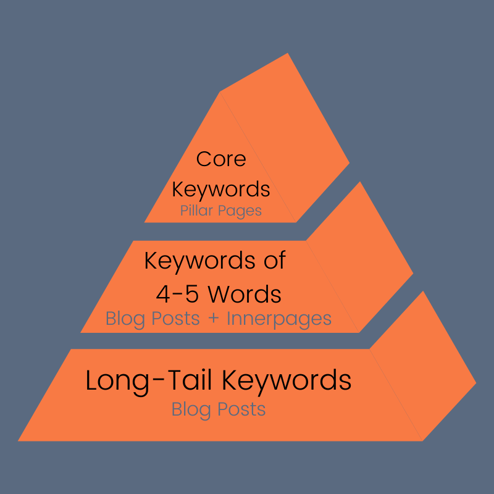
Create A List of Long-Tail Keywords To Support These Core Offerings
You’re going to need to support each of your core keywords because each of those keywords will become what is called a Pillar Page. Why is it called a Pillar Page? Because it will be the main page all of your long-tail keywords point back to.
Let’s pull JEEP GANG’s core keyword of “Jeep Air Compressor”. Since “Jeep Air Compressor” is the core keyword, it’ll have its own page on the website, that’s the Pillar Page.
Just having the page isn’t enough though. “Jeep Air Compressor” is highly competitive and will take a lot of work to rank.
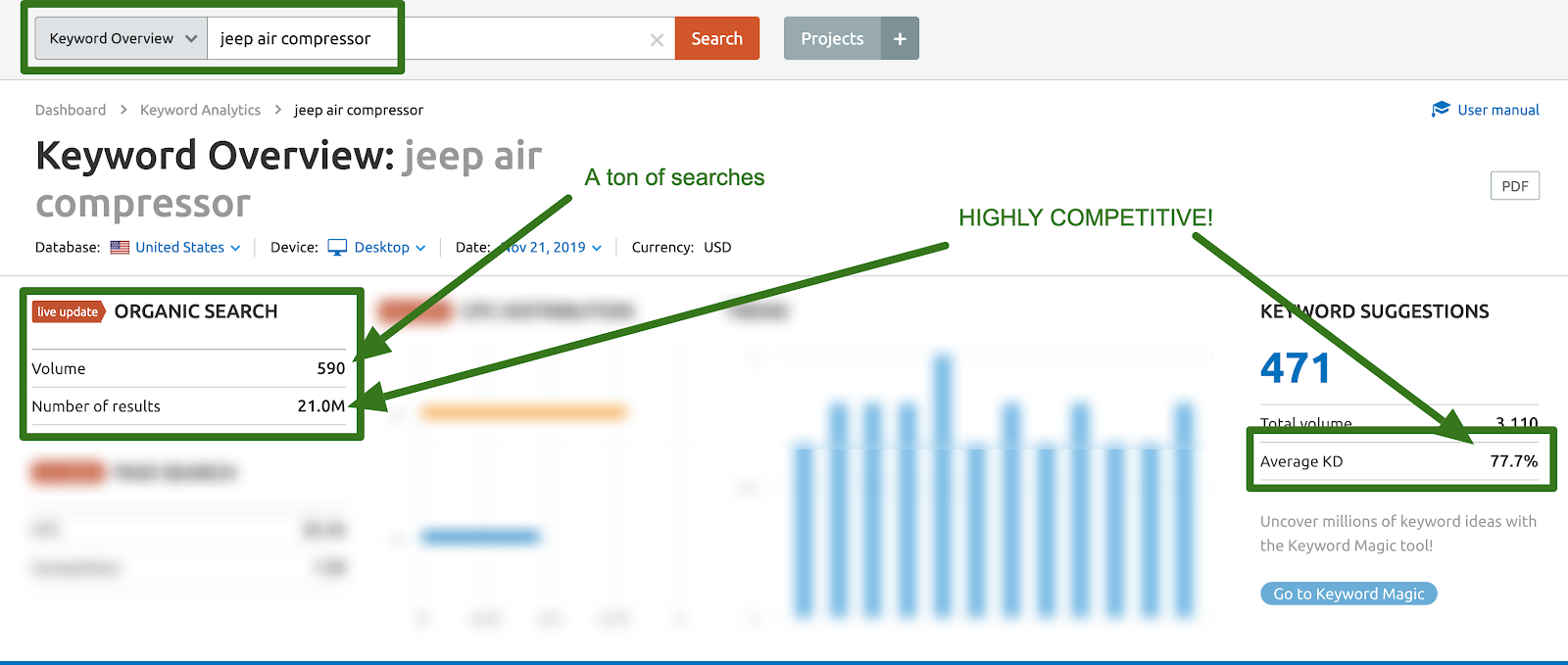
So what does JEEP GANG do? They build content around their Pillar Page in the form of blog posts.
These blog posts will feature the supportive long-tail keywords around the same topic of “Jeep Air Compressor” with a whole lot more specificity. These blog posts might have titles like:
- “Should you use an on board air compressor or a portable air compressor for your Jeep?”
- “How long before I have to replace my Jeep Wrangler air compressor?”
- “Buying Guide: Making sure you get the right Jeep JK air compressor for your needs.”
- “How to install a Jeep JK on board air compressor.”
- “What are the component parts of a Jeep Wrangler on board air compressor?”
- “How To: Installing a Jeep air compressor mount.”
- “Unboxing the Jeep air compressor kit [VIDEO]”
- “What’s the best value when buying an air compressor for a Jeep Wrangler?”
Each of these blog posts is highly specific. By talking about Jeep air compressors in different ways, you’re offering the consumer insight in many facets of why they might be searching for a Jeep air compressor in the first place.
Fortin says it best when he states:
“This allows a business to attract people who have varying interests in and concerns about owning their product -- and ultimately create more entry points for people who are interested in buying something.”
The Pillar Page at the root and the blog posts acting as subtopics to support it create what’s called a topic cluster.
If you have 10 core keywords (short-tail) it is advised to have a minimum of eight suptopics (long-tail keywords) to support it. That’s a lot of blogs but remember, you’re trying to appeal to various consumers’ intent. By doing so, you’re increasing the entry points to your site and making it more appealing to the eyes of the search engines when this content is quality and unique to you.
Here’s an example of what the single topic cluster would look like:
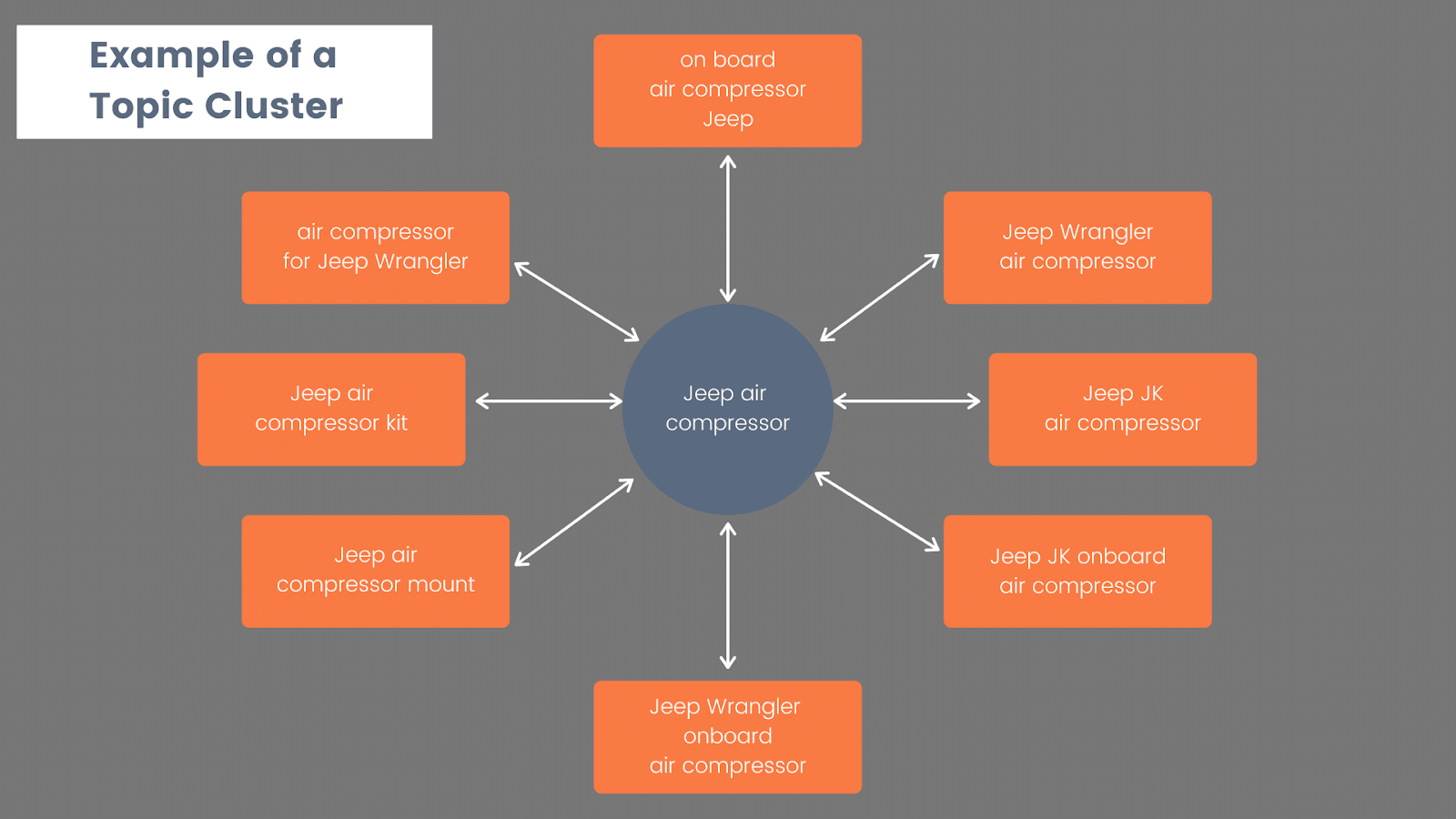
And here is what a content strategy built around topic clusters should look like:
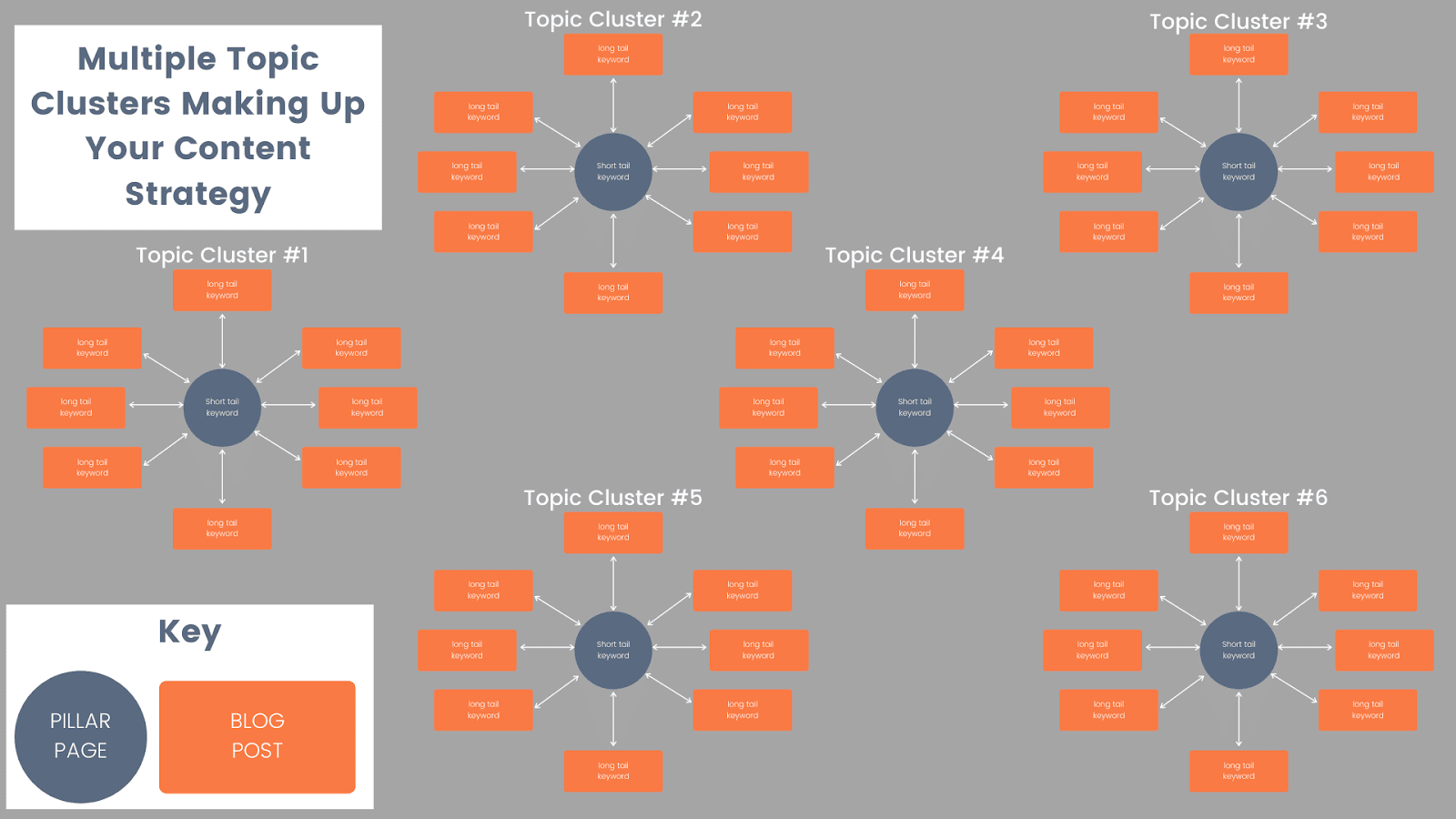
Not only are you using these blog posts to attract consumers. You’re also using them to build your website’s domain authority. Doing so will increase your likelihood of competing for top spots in Google for your products.
To make sure you’re accomplishing this goal with your blogs, keep the following in mind:
- The content has to be unique. This isn’t junior high where you can copy someone else and get away with it. Your content needs to be unique, current and relevant. It should be compelling to the point where someone who finds your post should want to read through it rather than bounce away.
- Make sure your current links are high quality. It’s all about association online. If you are associated with other high domain authority sites (ie: they are linking to you) then your website will increase in domain authority as well. If you have low domain authority sites linking to you, the reverse is true. To check who’s linking to you, check out a free backlink checker via SEMrush.
- Actively build your association with high domain sites. Once you write a piece of quality content, don’t stop there. Check out page one on Google and let those high domain authority sites know that you’ve written the most superb content on the issue. By requesting that instead of linking to your competitors that they link to your stunning piece of content, you’ll accelerate that authority building. It’s called the skyscraper method and it’s how a company called Backlinko increased their organic traffic by over 100% in two weeks.
Have Your Own Voice When You Write This Stuff
Listen, if you’re trying to get to the top pages of Google using topic clusters and high-quality content creation, do you think you’re going to displace those at the top by saying the same things they are?
Of course not!
You need your own voice online to stand out. I’m not saying you need to write the most clickbaity content out there but being dry and “so last year” isn’t going to convert those visitors into leads either.
Lance Cummins, the owner of Nectafy actually did a 5 year case study on switching over from WordPress to HubSpot. If you have 30 minutes to give it a read, I highly recommend it.
Lance saw tremendous success following the topic cluster model, not only because he was following all the rules and going all in, but because he gave his own unique spin to every topic and subtopic out there. Customers love that!
Here’s his take on the importance of adding your voice to your content strategy:

Track It Like Crazy
If you’re going to go this route for your SEO strategy than Google Analytics needs to be your life!
Watching the data roll in on your content will let you know how well it’s doing and how much more you need to do with it. If you post it and leave it, what good is it doing you?
If your goal is to rank on page one of Google, you need to monitor the organic search traffic that is arriving to your site. Check out a few key metrics to make sure it’s doing well like, time on page, page entrances, page exits, and the overall bounce rate of your site.
Once more, if you have set up custom conversions in Google Analytics, you can see what pages are producing your highest converters and what pages need a little help.
But that’s just paying attention to what’s happening ON your website. Using tools like SEMrush or KWfinder will help you see how you're stacking up against the competition as well.
Once you have all this data, it should tell you over the course of the next 6-18 months what you should be doing with your content.
Say one of your posts is absolutely killing it. It’s seeing gains in traffic and entrances from organic search all the time for 15 straight months and then it starts to level off and even drops in traffic the next few months. This is an indicator it’s time to freshen up the content.
In a perfect world, your content can be evergreen and you won’t have to come up with new topics later on at the same rate you do when you get started. A post that’s done well but is starting to drop off in performance is a good candidate for an update in the content or added media. Dropping in a podcast, a video or a new infographic should help continue to push the rock-solid numbers on that post for months to come.
Finally, it’s always a good idea to respond to comments on these posts. Remember, they are entry points for all kinds of consumers. Nurture those consumers. Be the authority and helpful guide for their questions and comments. It’s like social media except they are physically on your site. I can’t think of a better time to engage with them.
Partnering with a Top-Rated Agency to Increase Your Site’s Visits, Leads and Sales
Search engine optimization strategies take a lot of work, planning and expertise. Most people want to go the route of trying SEO themselves before paying an agency to do it but many find out how counterintuitive it is.
Remember, your website should be the #1 employee at your company whose only job is to turn one-way communication into two-way communication. It doesn’t take any vacation or sick days. It doesn’t collect a 401k, medical, dental or vision. It doesn’t complain and it doesn’t ask for a raise.
But it also doesn’t just rank in Google because it’s there.
Partnering with a digital marketing agency to increase the visibility to your website, resulting in more site visits, leads and sales is vital to improving your company.
While there are thousands of digital marketing firms out there, at all sorts of price points, Agency Jet is one of the most affordable SEO companies in the country.
To get an entire team of people working on your website for one of our average campaigns is the equivalent to paying one full-time employee only $10.38/hr. And we don’t take 401k, medical, dental or vision.

Our sole job at that price is to improve the website and make it your #1 employee.
To learn more about Agency Jet you can check out our case studies, meet our team or read our story.
Or, take advantage of our always 100% free and always 100% educational (no sales pitch included) website assessments. It gives a great baseline for where your website's at and how you can start improving it today!
Author: Colby Wegter, Director of Client Strategy
More Resources
